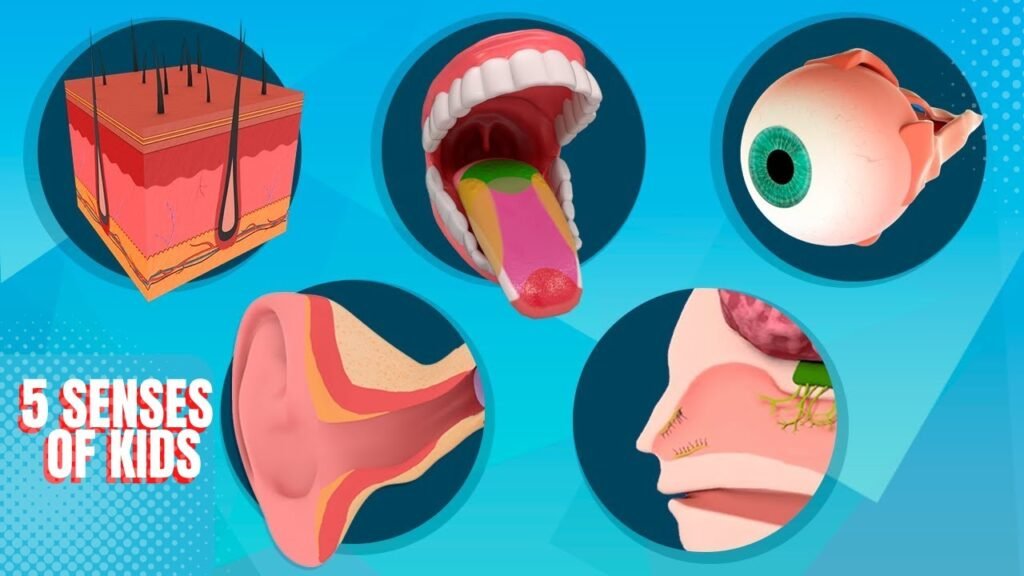Overview of Smell and Taste in Human Body
Introduction
As mentioned before smell and taste are sometimes referred to as the chemical human senses because they both involve chemoreceptors, receptors that are sensitive to certain chemical molecules rather than to electromagnetic or mechanical energy chemical stimulation of these receptors initiates transduction and the transmission of nerve impulses to the brain.
Smell and taste receptors are located near each other and often interact so closely those we have difficulty in separating the sensations. You can test this for yourself by closing your eyes and biting into an onion, an apple, and a potato while holding your nose closed. You will find that it is much more difficult to distinguish the three tastes without the aid of your smell receptors.
In fact, smell plays a major role in the sense of taste. Have you ever noticed how food seems bland when your nose is blocked by a cold and you are unable to smell your food? The interaction between taste and smell is also affected by the temperature of food. Pizza and pancakes are much “tastier” when hot than cold-the steam from the hot foods enhances their taste because it can stimulate the smell receptors.
Chemical senses play an important role in the survival of many animals-in mating, detecting enemies, and locating food. Some people have come to rely to these senses more than the average person. However, for most people, smell and taste seem to be more a matter of aesthetics than survival.
We often first smell food to determine if it is spoiled, and the smell of smoke serves as clear warning of fire.
Senses of the Human Body

The Sense of Smell, Or Olfaction
Some of very recent researches indicate that the sense of smell may help babies to recognize their mothers. When infants are only six days old, they can distinguish between their mother’s scent and that of a strange woman.
The human sense of smell, however, is not essential for life. Lord Adrian suggested that losing the sense of smell would be roughly as becoming color blind.
Nevertheless, other animals do depend on smell for survival, just under the base of the brain. The receptor cells send axons up through smell holes in the bone above the olfactory mucosa. The axons synapse on neurons in the olfactory bulbs, which are enlargements at the ends of the stalk like olfactory nerves. We do not yet know how olfactory receptor cells detect odors. The most widely accepted hypothesis is that the interaction between odor molecule and receptor is similar to that of transmitter substance and post-synaptic receptor on a neuron.
The sense of smell, or olfaction, results from stimulation of receptor cells in the nose the nasal cavity in a mucus-coated membrane called the olfactory epithelium. The olfactory epithelium is accessible from the mouth, via the oral-nasal connection at the top of the throat, which accounts for the strong contribution of smell to taste.
The olfactory receptors are actually modified neurons, with a branched set of dendrites extending out of the epithelium. When air molecules in the nasal cavity come in contact with the dendrites, they initiate a neural impulse than travels along the neuron’s axon directly to the olfactory bulb in the brain. In the olfactory bulb, most of the olfactory information is processed before being sent to other parts of brain.
As noted earlier, smell receptors adapt very quickly. Odors that initially seem overpowering soon seem to wear off. Furthermore, some people adapt to smells more quickly than other. Smell acuity is generally keen-we can detect up to tens of thousands of different odors-but it also seems to vary among individuals. Some of us are totally “blind” to certain odors (such as musk and sweat), and some older people suffer a complete loss of smell. The exact reasons for these variations are still unclear, but current research is looking at the roles of heredity, hormones, and learning.
How do we Smell?
The anatomy of the olfactory system shows that the receptor cells lie in the olfactory mucosa. These one-inch-square patches of mucous membrane are located on the roof on the nasal very large.
It seems unlikely that we have separate receptors for each odor. Such a requirement would involve a phenomenal number of different receptors. Moreover, it would not explain the fact that we can smell and learn to identify new, synthetic chemicals that were not in existence while our olfactory system was evolving.
Human Sense of Taste for Kids

Smell and taste (gustation) are called chemical senses because our noses and tongues respond directly to the presence of chemicals in the air we breathe and in the foods we eat, many animals rely on chemical stimuli for information-to identify food, to warn themselves of enemies. Humans, too, use smells and taste to gather information, but in more limited way. Like most creatures, we have, to decide what to eat and what not to eat. Our sense of smell and taste help us make those decisions.
The senses of smell and taste typically work together, and distinctive tastes usually have an important odor component.
There appear to be just four basic tastes:
Sweet, sour, salty and bitter, it is their chemical properties that make substances taste as they do. For example, Acidic compounds often taste sour, whereas those that have a metal ion, such as sodium or potassium, may taste salty. However, the exact relationship between chemical structure and taste is complex and not fully understood.
Von Bekesy (1964) was the first to study individual taste buds elector-physiologically. He found that electrical or chemical stimulation produced only a single sensation, and he concluded that each papillae is specific for one of the four taste qualities. However, Baler and smith (1975) later found that one third of the papillae they tested produced responses to stimuli of all four taste qualities.
In recent years, the concept of four primary taste sensations has been challenged by the discovery that different cultures disagree about the number of primary tastes. Some Native Americans and some inhabitants of the pacific Islands recognize fewer than the four primary tastes listed earlier. The Japanese recognize a fifth, which they call Umami (Yamaguchi 1979). This seems to be the taste of amino acids, the building blocks of protein.
Senses of the Tongue

The surface of the tongue is differentially sensitive to taste. The tip is more sensitive to sweet and salty substances; the sides to sour substances, and back of the tongue, the back of the throat and soft palate overhanging the back of the tongue can detect the bitter substances.
If you examine your tongue in a mirror, you can see that it is covered with small bumps called papillae. Each of these papillae is separated from its neighbors by small valleys. Located on the walls of the papillae that form these valleys are your taste buds, which contain the sensory receptors. Each of them approximately 9,000 human taste buds contains forty to sixty taste receptor cells. When substances enter the mouth they penetrate tiny pores in the papillae and stimulate the taste receptors.
By a mechanism not yet fully understood, the stimulation produces a neural response. Unlike sensory cells in other systems, a completely new set of taste receptor cell are produced about every eleven days. We know that different receptors on the tongue respond differently to the various tastes. But there may be more than one kind ok receptor for each of the basic taste. People can discriminate between two different sugars (beet and cane sugar), even though both are sweet. And there is evidence that individual receptors respond to several substances but most strongly to one.
Nerve Fiber Definition and Function
The nerve fibers convey information from the cells within the taste bud to the brain. These individual nerve fibers are also differentially sensitive to the four basic tastes; while they respond to a wide range of taste stimuli, they respond best to only one.
If a region of the tongue is stimulated continuously with a specific taste for around 10 seconds or more, sensitivity to that taste will quickly decline. This process is called adaptation. It can be observed in all sensory systems. Following continuous exposure to salty tastes, the threshold to that taste decline until it can hardly be detected.
This explains why some people salt and result their food. As they eat the salt food they adapt to the salty taste, and therefore, they need a higher concentration of salt to achieve the same taste. To avoid this problem you should eat something that is not salty between bites of salty food. The same principle of adaptation holds for other taste as well.
The sense of taste of course, does not operate simply through the tongue, as anyone with a stuffy nose can confirm. The smell, temperature, texture and even appearance of food all affect our sense of taste. Furthermore, some people are more sensitive to certain tastes than are other, and the ability to taste certain substances runs in some families. Our own behaviors and habits also play a role in our tasting capabilities; smoking for example, dulls the taste of food.
What is Taste Blindness and its Causes

No doubt, there are wide variations in taste sensitivity; some of us may be taste blind, for specific substance. This phenomenon was discovered in 1931 when two chemists in the du Pont laboratories accidently spilled a substance called PTC. One chemist noted that it gave the air a bitter taste, while other noticed nothing. Further investigation revealed that thresholds to PTC vary widely; everyone can taste it sooner or later, but some people only notice high concentrations. The fact that most people do not know whether or not they are taste-blind again calls attention to the modest role of taste in human affairs.
Taste sensation can also be produced by some rather odd stimuli. Electrical stimulation of certain taste buds can produce either sour or soapy tastes, depending on the direction in which the current flows. Injections of certain drugs can produce sweet or bitter tastes. This reminds us that the inner world of experience does not depend directly upon external stimulation; sensation result from electrical and chemical events in the nervous system. Learn more about the Human Senses in detail.
Read More: 5 Senses of the Human Body
The Skin Structure and Function
The senses hearing, vision, and smell are like long-distance phone calls. They bring us information about events that are often at a distance from our bodies. But stimuli for the skin senses-touch, temperature, and pain-involve events at or just below the body’s surface.
Since Aristotle, many people have smoke of five major senses; vision, hearing, taste, smell and touch. Psychologists accept the first four but expand the fifth, touch, to include four separate skin senses (pressure, warmth, cold and pain) and two internal senses, (balance and muscle movement).
Sensitivity of the Skin

When the skin is mapped by applying a small stimulus to one point after another, some points are found to be responsive to cold stimuli, while others are sensitive to warmth and not to cold. This is the major source of evidence for the claim that cold and warmth are separate sensations.
FAQs Human Ear
How Many Senses Does a Human Have
A human has five senses: sight, smell, taste, touch, and hearing. These senses allow us to perceive and interact with the world around us.
What are the 21 Human Senses
The traditional five senses are sight, smell, taste, touch, and hearing. Some people believe that there are additional senses beyond these five, including:
- Temperature sense: the ability to perceive hot and cold
- Proprioception: the sense of the position and movement of the body
- Nociception: the sense of pain
- Equilibrioception: the sense of balance and spatial orientation
- Time sense: the perception of time passing
- Sense of direction: the ability to determine one’s position and orientation in space
It’s important to note that there is ongoing debate among scientists about whether these additional senses exist as distinct entities or if they are just different ways of perceiving the world through the traditional five senses.
What is the Sixth Sense of Human
The term “sixth sense” is often used to refer to extrasensory perception or the ability to perceive things beyond the five traditional senses of sight, smell, taste, touch, and hearing. This can include things like telepathy, precognition, and clairvoyance.
Some people believe that everyone has a sixth sense and that it can be developed and strengthened through practice and training. However, there is no scientific evidence to support the existence of extrasensory perception, and the concept remains a topic of debate and speculation.
Signals to Trigger All Five Human Senses Can Be Digitized
It is possible to digitize signals that can trigger the five human senses of sight, smell, taste, touch, and hearing. For example:
- Sight: Digital images and videos can be displayed on screens or projected using virtual reality technology to trigger the sense of sight.
- Smell: Some digital devices have the capability to release scents using special cartridges or through the use of essential oils.
- Taste: Some digital devices have the capability to stimulate the sense of taste using electrical stimulation or by releasing flavored chemicals.
- Touch: Digital devices can provide haptic feedback, which is the sensation of touch, through the use of vibrations or pressure.
- Hearing: Digital audio files can be played through speakers or headphones to trigger the sense of hearing.
However, it’s important to note that the experience of the five senses can be quite different when triggered digitally compared to when they are experienced in the real world. The resolution, intensity, and overall quality of the sensory experience may not be the same as it would be in person.
What is the Fastest Human Sense
The fastest human sense is sight. The speed of light is about 300,000 kilometers per second, and the process of seeing involves the transmission of visual information from the retina to the brain. This process happens extremely quickly, allowing us to see and react to things almost instantly. The other senses, such as hearing, touch, and taste, are slower and may not be as essential for survival in the same way that sight is.
Archaeology and the Senses Human Experience Memory and Affect
Archaeology is the study of human history and culture through the excavation and analysis of physical remains. The senses play a key role in the way that archaeologists understand and interpret the past. For example:
- Sight: Archaeologists rely on their sense of sight to identify and analyze artifacts, structures, and other physical remains.
- Smell: The sense of smell can be used to identify and analyze organic materials, such as food residues or plant remains.
- Taste: The sense of taste can be used to identify and analyze food and drink remains.
- Touch: The sense of touch can be used to identify and analyze the texture and properties of artifacts and other remains.
- Hearing: The sense of hearing can be used to identify and analyze the sounds produced by artifacts and structures, such as musical instruments or doorways.
The human experience of memory and affect is also an important aspect of archaeology. By understanding how people in the past used and experienced objects and spaces, archaeologists can gain insights into the social, cultural, and emotional aspects of human history.






